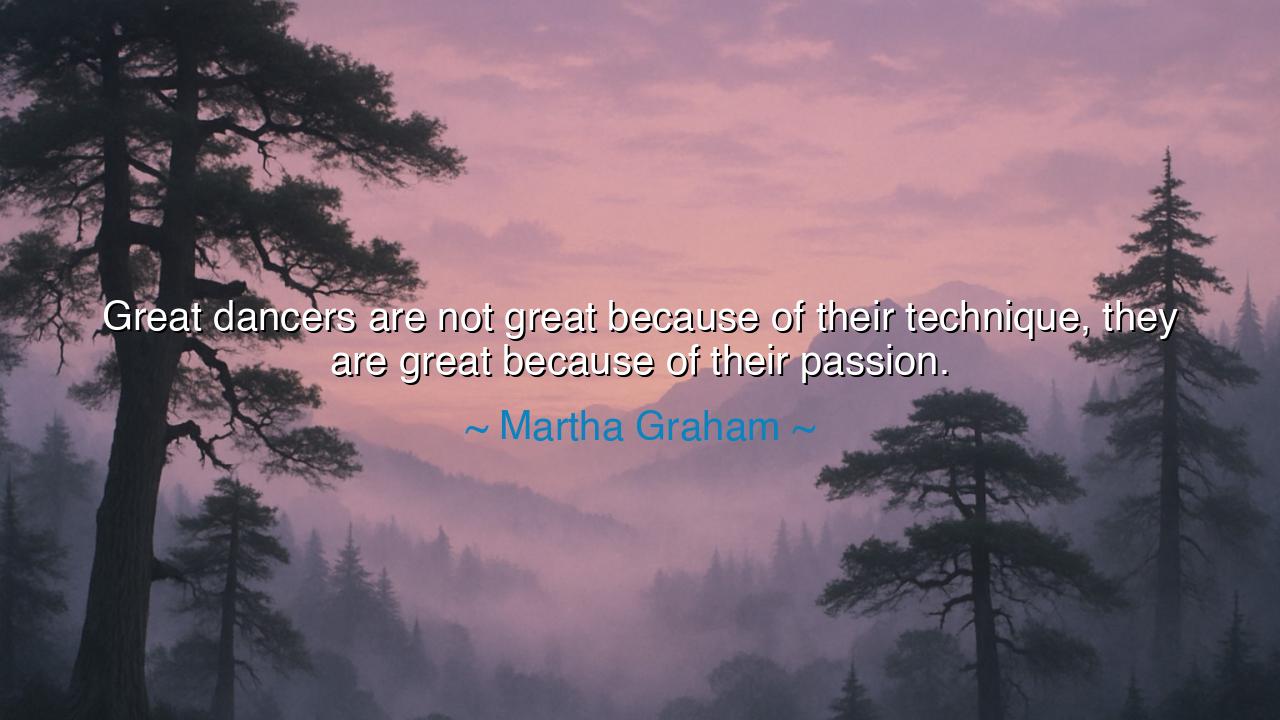
Great dancers are not great because of their technique, they are
Great dancers are not great because of their technique, they are great because of their passion.






“Great dancers are not great because of their technique, they are great because of their passion.”
So spoke Martha Graham, the high priestess of modern dance, whose art reshaped the very language of human movement. Her words, though simple, contain a truth that reaches beyond the stage — into the heart of all creation, all mastery, all life. For technique is the body’s obedience, but passion is the soul’s fire. Technique alone can craft beauty, but only passion can breathe into it the breath of eternity.
The origin of the quote lies in Graham’s own rebellion against perfection as the world defined it. In an age when dance was bound by rigid rules and graceful symmetry, she tore away convention to reveal the raw, trembling power of emotion. Her dancers did not move like angels; they moved like mortals — flawed, vulnerable, yet radiant in their sincerity. Through their movement, she declared that art is not about flawless execution, but about truth made visible through the body. Passion, not precision, is what awakens the divine in motion.
To understand her meaning, one must look deeper into the soul of art itself. The ancients believed that creation was an act of possession — that the Muse did not visit the careful, but the consumed. The potter could learn the shape of clay, the sculptor the weight of stone — but without the flame of spirit, their works were empty shells. So too with dance. A dancer who knows every step but feels nothing dances only for the eyes. But one who moves with passion dances for the soul, and their motion becomes eternal. Graham herself said that the body never lies. Passion cannot be faked; it spills out, unbidden, from the deepest chambers of being.
History is filled with those who proved this truth in every field of endeavor. Vincent van Gogh, who had no formal mastery of proportion or polish, painted with such burning emotion that his canvases seem to breathe. Beethoven, deaf and tormented, wrote symphonies that shook the heavens, not from technical perfection, but from the pain and exultation of his heart. So it is in dance — and so it is in life. Technique is the scaffolding; passion is the cathedral that rises from it. Without passion, even the most precise art is sterile; with it, even imperfection can become divine.
Martha Graham’s own life was the living testament of her quote. She once said, “There is a vitality, a life force, a quickening that is translated through you into action, and because there is only one of you, this expression is unique.” To her, passion was not mere emotion, but a sacred responsibility — the act of expressing what only one soul can bring into the world. The dancer, therefore, is not a performer, but a vessel; the dance, not an act of skill, but an act of surrender. In passion, the dancer ceases to exist — only the truth remains.
Yet passion, though it exalts, also demands sacrifice. For to live with passion is to live vulnerably — to expose one’s inner self before the world. Technique can be taught in safety; passion must be lived in courage. The dancer who embraces passion must risk failure, ridicule, exhaustion. And yet, that is the price of greatness. The ancients knew this well. The hero who trembles but steps forward is greater than the one who never doubts. The artist who bleeds into her craft creates not for applause, but for eternity.
Let this be the lesson for all who seek mastery — in art, in work, in life: Do not mistake skill for greatness. Learn your craft, yes; sharpen your tools, yes — but never let the flame of passion die beneath the weight of perfection. Passion is the sacred spark that turns discipline into destiny. When your body grows tired and your spirit falters, remember why you began — remember the love that first set you aflame.
For as Martha Graham teaches us, greatness does not dwell in the hands or the feet, but in the heart that moves them. Technique is learned; passion is lived. The former builds the stage, but the latter brings it to life. And when you act, speak, create, or love with true passion — then, like the dancer in Graham’s vision, you no longer move through life… life itself moves through you.






AAdministratorAdministrator
Welcome, honored guests. Please leave a comment, we will respond soon